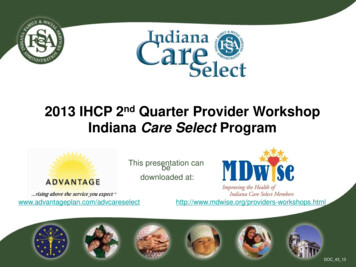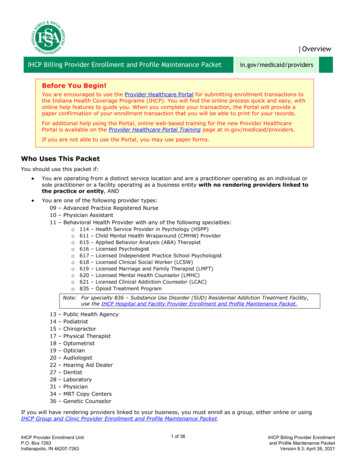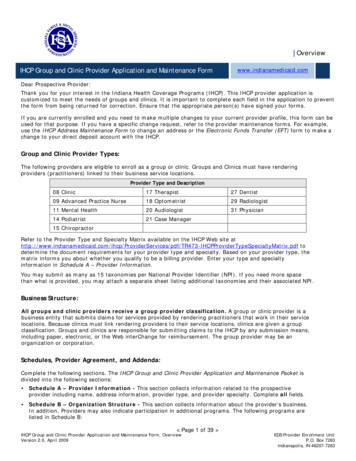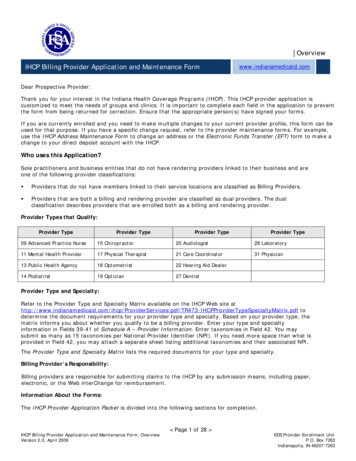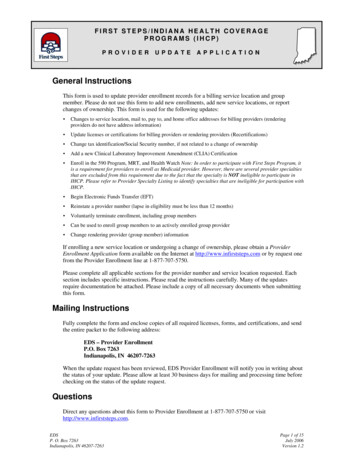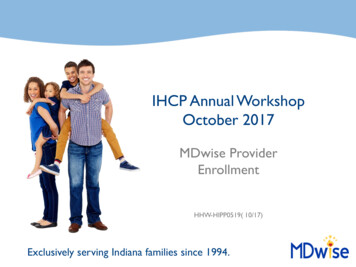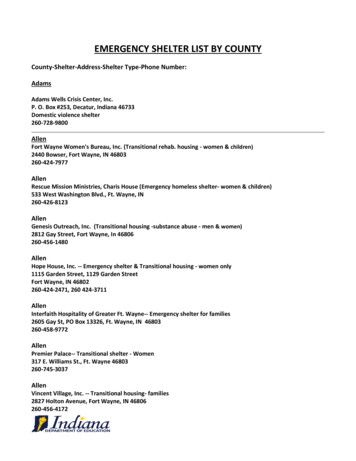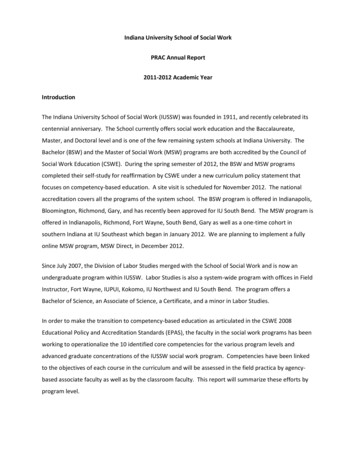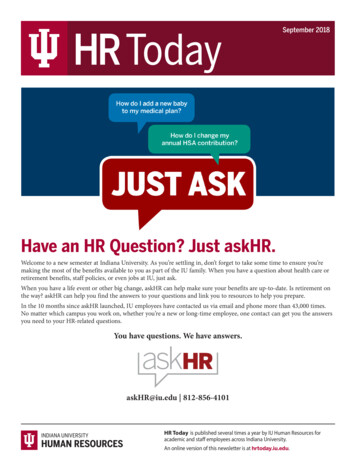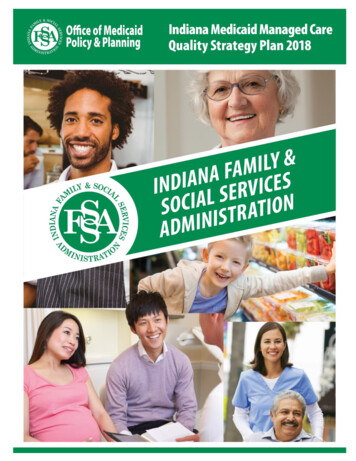
Transcription
2018 IHCP Quality Strategy GuideTable of ContentsSECTION I. Introduction . 4Managed Care Goals, Objectives, and Overview. 4Overview of Indiana Health Coverage Programs. 4History and Overview of IHCP’s Risk-Based Managed Care Programs . 5Hoosier Healthwise (HHW) . 5Hoosier Healthwise Strategic Objectives for Quality Improvements 2018 . 6Healthy Indiana Plan (HIP) . 7HIP Strategic Objectives for Quality Improvement 2018 . 8Overview of Traditional Medicaid Populations . 9Traditional Medicaid Strategic Objectives for Quality Improvement 2018. 10Hoosier Care Connect . 10Hoosier Care Connect Strategic Objectives for Quality Improvement 2018 . 10Development and Review of Quality Strategy . 11SECTION II. Assessment . 14Quality and Appropriateness of Care . 14National Performance Measure . 14Monitoring and Compliance . 14External Quality Review (EQR). 16SECTION III. State Standards . 17Access Standards . 17Availability of Services . 17Assurances of adequate capacity and services . 20Coordination and continuity of care. 24Coverage and authorization of services . 25Structure and Operations Standard. 27Provider Selection: Provider Enrollment and Disenrollment . 27Enrollee Information. 28Confidentiality . 30Grievance Systems . 31Sub-Contractual Relationships and Delegation . 31Measurement and Improvement Standards . 32Practice Guidelines . 33Quality Assessment/Performance Improvement . 33MCE Health Information Systems . 38SECTION IV. Improvement and Interventions . 40Improvements . 40Intermediate Sanctions. 42State Health Information Technology . 45SECTION V. OMPP 2018 Initiatives . 47Initiatives for 2018 . 47Hoosier Healthwise. 47Healthy Indiana Plan . 47Hoosier Care Connect . 47Right Choices Program. 472
2018 IHCP Quality Strategy GuideReimbursement and Financial Reporting . 47Policy Governance . 47Monitoring and Reporting Quality . 48Improving Birth Outcomes . 48Pharmacy Alignment . 48Section VI. Conclusion. 49Appendix I: Risk-Based Managed Care Historical Timeline . 50Appendix II: Hoosier Healthwise Historical Timeline . 52Appendix III: Healthy Indiana Plan & Enhanced Services Plan Historical Timeline. 53Appendix IV: Care Select Historical Timeline . 54Appendix V: Hoosier Care Connect Historical Timeline . 55APPENDIX VI: Progress Updates on Previous Initiatives . 56Progress Update for the 2017 Hoosier Healthwise Initiatives . 56Progress Update for the 2017 Healthy Indiana Plan Initiatives. 58Progress Update for the 2017 Hoosier Care Connect Plan Initiatives . 60Progress Update for the 2017 Traditional Medicaid Initiatives. 613
2018 IHCP Quality Strategy GuideSECTION I. IntroductionManaged Care Goals, Objectives, and OverviewOverview of Indiana Health Coverage ProgramsIndiana continues to engage in activities to improve the lives of its members through planning and initiativesconcentrating on timely access to health care, quality and cost management in Medicaid managed care. Thisstrategy includes an interdisciplinary, collaborative approach through partnerships with enrollees, othergovernmental departments and divisions, providers, contractors, Managed Care Entities (MCE), academics, aswell as community and advocacy groups.The Indiana Family and Social Services Administration (FSSA) is the single State agency responsible foradministering Medicaid programs. Per the US Census Bureau, the population of Indiana in 2015 was 6.619million. Per FSSA’s Data and Analytics unit, the Medicaid enrollment in December of 2017 was 1,440,917, ofwhich 1,147,658 were in managed care. Thus, Medicaid provides vital health care to approximately one in fiveHoosiers. In 2017, Indiana’s health care coverage will include services through the Hoosier Healthwise program(HHW), Children’s Health Insurance Program (CHIP), Healthy Indiana Plan (HIP), Hoosier Care Connect (HCC)or fee-for-service (FFS). Indiana’s risk-based managed care (RBMC) programs include HHW, HIP and HCC.The CHIP members may be served through RBMC or FFS.The FSSA Office of Medicaid Policy and Planning’s (OMPP) Quality and Outcomes Section is charged withoversight of the Managed Care Entities through reporting, contract compliance and quality initiatives specific tothe HHW, CHIP, HIP and HCC programs. The OMPP Quality and Outcomes staff provide oversight to the healthplans by monitoring data and reporting, seeks opportunities to enhance the quality of care provided to members,and contract compliance monitoring and supervision. Data collection and reporting is facilitated through thehealth plans’ quarterly and annual self-reporting as well as through the Enterprise Data Warehouse program-widereports.OMPP Quality and Outcomes staff utilize data reporting for ongoing quality initiatives to identify areas forimprovement. The contracted health plans must meet contract requirements which include developing a QualityManagement and Improvement Program (QMIP) for each line of State business to monitor, evaluate and takeaction on aspects that impact the quality of care provided to members. Four important components of the QMIPare: the plan’s Consumer Assessment of Healthcare Providers and Systems (CAHPS), Healthcare EffectivenessData and Information Set (HEDIS), meeting the requirements of the National Committee for Quality Assurance(NCQA) and addressing opportunities for improvements identified in the External Quality Review. In addition tothe plans’ QMIP, each plan must annually conduct and submit to OMPP their CAHPS and HEDIS results and theNCQA rankings.Since 80% of the delivery of health care in 2018 to Indiana Medicaid members is via a managed care model, it isIndiana’s goal to ensure that the contracted health plans not only perform the administrative functions of a typicalinsurer, but also be adept at addressing the unique challenges and needs of low-income populations. The plansare also expected to manage and integrate care along the continuum of health care services. OMPP expects thecontracted health plans to: Improve overall health outcomes Foster personal responsibility and healthy lifestyles Increase consumer knowledge of health care by increasing health care literacy as well as providing priceand quality transparency. Improve access to health care services Engage in provider and member outreach regarding preventive care, wellness and a holistic approach tobetter health4
2018 IHCP Quality Strategy Guide Develop innovative utilization management techniques that incorporate member and provider educationto facilitate the right care, at the right time, in the right locationTo ensure that these expectations are met, Indiana oversees the allocation of care throughout multiple means administratively, fiscally and through the delivery of member services, provider services, service utilization, caremanagement and claims payments. Medicaid Quality and Outcomes may use corrective action(s) when acontracted health plan fails to provide the requested services or otherwise fails to meet their contractualresponsibilities to the State. It is the mission of the State to ensure that members receive services in an efficientand effective manner.The four MCEs contracted with the State of Indiana are Anthem Insurance Companies, Inc. (Anthem),Coordinated Care Corporation, Inc. d/b/a Managed Health Services (MHS), MDwise, Inc., and CareSource. TwoMCEs, Anthem and MHS, have the HHW, HIP and HCC lines of business for risk-based managed care. The othertwo MCEs, MDwise and CareSource, have the HHW and HIP lines of business for risk-based managed care. TheMCEs are expected to achieve the goals and objectives set forth by OMPP and manage the care of membersenrolled in the HHW, HIP and HCC programs.OMPP has identified four global aims that equally support HHW, HIP and HCC goals and objectives. These are:1. Quality – Monitor quality improvement measures and strive to maintain high standardsa) Improve health outcomesb) Encourage quality, continuity and appropriateness of medical care2.Prevention – Foster access to primary and preventive care services with a family focusa) Promote primary and preventive careb) Foster personal responsibility and healthy lifestyles3.Cost – Ensure medical coverage in a cost-effective mannera) Deliver cost-effective coverageb) Ensure the appropriate use of health care servicesc) Ensure Utilization Management best practices4.Coordination/Integration – Encourage the organization of patient care activities to ensure appropriate carea) Integrate physical and behavioral health servicesb) Emphasize communication and collaboration with network providersHistory and Overview of IHCP’s Risk-Based Managed Care ProgramsCollectively, Hoosier Healthwise, Hoosier Care Connect, and the Healthy Indiana Plan share in ensuring members’access to primary and preventive care services by seeking to improve quality, continuity and appropriateness ofmedical care. The historical timeline for Indiana’s risk-based managed care program is contained in Appendix 1.Hoosier Healthwise (HHW)Indiana established the HHW program in 1994 under the administration of OMPP. The State first introduced aPrimary Care Case Management (PCCM) delivery system called PrimeStep. Two years later, the State added a riskbased managed care (RBMC) delivery system made up of MCE contracted health plans, which are HealthMaintenance Organizations (HMOs), authorized by the Indiana Department of Insurance, and contracted withOMPP. The historical timeline may be found in Appendix 2.HHW provides health care coverage for low income families, some pregnant women, and children. The programcovers medical care including, but not limited to, doctor visits, prescription medicine, mental health care, dentalcare, hospitalizations, surgeries, and family planning at little or no cost to the member or the member's family. Based5
2018 IHCP Quality Strategy Guideon a February 1, 2018 waiver approval all newly pregnant women will be enrolled and served in the Healthy IndianaPlan (HIP).HHW members are eligible for benefits either through Medicaid or through the Children’s Health InsuranceProgram (CHIP). CHIP health care coverage is for children up to age 19 and available to members who may earntoo much money to qualify for the standard HHW coverage. A child may be covered in CHIP Package C by payinga low-cost monthly premium.Hoosier Healthwise Strategic Objectives for Quality Improvements 2018The development of the HHW Quality Strategy Initiatives is based on identified trends in health care issues withinthe State of Indiana, attainment of the current quality strategy goals, close monitoring by OMPP of the ManagedCare Entities’ performance and unmet objectives, opportunities for improvement identified in the External QualityReview (EQR) and issues raised by external stakeholders and partners. OMPP has outlined initiatives for 2018specific to the HHW Program in Table 1. Some of these objectives have been monitored and maintained fromprevious years, while other measures are new for the 2018 Quality Strategy.TABLE 1OBJECTIVE1. Improvements in Childrenand Adolescents Well-Care(HEDIS)Percentage of members with wellchild visits during first 21 years oflife. HEDIS measure using hybriddata.2. Early Periodic Screening,Diagnosis and Treatment(EPSDT)3. Improvement in BehavioralHealth (HEDIS) Percentage ofmembers who received follow-upwithin 7 days of discharge fromhospitalization for mental healthdisorders4. Ambulatory Care (HEDIS)Number emergency departmentvisits per member months5. Frequency of Prenatal Care(HEDIS)2018 Hoosier Healthwise InitiativesMETHODOLOGYOMPP utilizes HEDIS measures fortracking the percentages of well-childservices in children and adolescents.GOALAchieve at or above the 90thpercentile for improvements inchildren and adolescent well-child(HEDIS).OMPP is aligning its EPSDT programrequirements with the AmericanAcademy of Pediatrics Bright FuturesGuidelines. OMPP anticipates thecontracted health plans will providefollow-up and outreach to providersabout the Bright Futures Guidelinesand provider toolkits.OMPP uses HEDIS measures fortracking the percentages of membersreceiving follow-up.Achieve at or above 80%participation rate in the EPSDTprogram.OMPP is using HEDIS AMB to trackthe utilization of ambulatoryoutpatient and emergency departmentvisits to promote best practices inUtilization Management.OMPP is using HEDIS for trackingthe frequency of women receivingprenatal care.Achieve at or below the 10thpercentile of AmbulatoryEmergency Department CareVisits (HEDIS).Achieve at or above the 90thpercentile for members whoreceive follow-up within 7 days ofdischarge from hospitalization formental health disorders (HEDIS).Achieve at or above the 90thpercentile for the frequency ofprenatal care.6
2018 IHCP Quality Strategy GuideTABLE 12018 Hoosier Healthwise InitiativesMETHODOLOGYOMPP is using HEDIS for trackingthe percentage of children 2 years ofage who had one or more capillary orvenous blood lead tests for leadpoisoning by their second birthday.OMPP is using HEDIS for tracking5. Medication Management forthe percentage of members, aged 5-11People with Asthmayears, who remained on an asthmacontroller medication for at least 75%of their treatment period.OMPP monitors monthly data to6. Right Choices Programassess the contracted health plans’(RCP):Provide quality health care through utilization management efforts tohealth care management; RCPreduce inappropriate hospital,administrators conduct utilizationpharmacy, and physician utilizationreviews, create a care coordination while making efforts to improve theteam and collaborate with themember’s health status and increasemember to ensure that the member provider participation in the RCPreceives appropriate, medicallyprogram.necessary care.OBJECTIVE6. Lead
2018 IHCP Quality Strategy Guide 5 Develop innovative utilization management techniques that incorporate member and provider education to facilitate the right care, at the right time, in the right location To ensure that these expe
